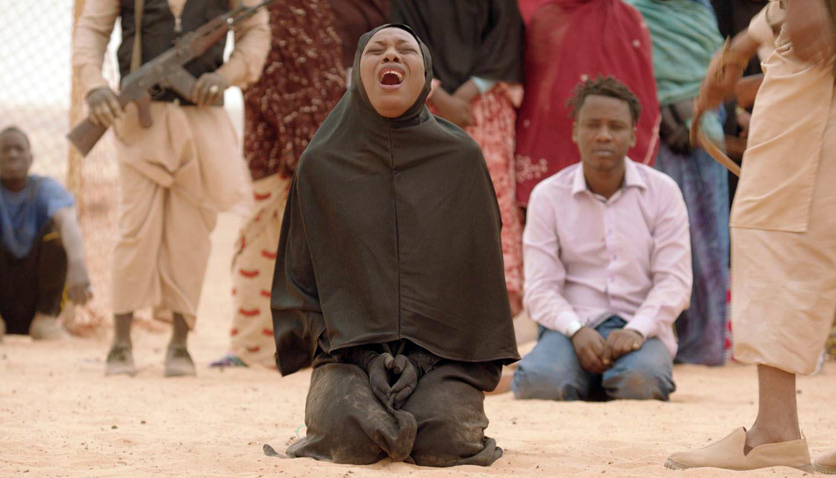
While Mauritanian-born director Abderrahmane Sissako has premiered three films in Cannes (winning a number of prizes including the FIPRESCI), and has served on three of its juries including the Competition jury in 2007, “Timbuktu” represents his first film In Competition. This unusual profile, coupled with Sissako’s (rightly) outspoken opinions on the underrepresentation of African filmmaking in the average international festival lineup might lead one to suspect a degree of tokenism in this film’s inclusion in the main competition this year. But they are suspicions that the film quickly lays to rest: “Timbuktu” inarguably stands on its own merits as a distinctive film told with both authenticity and artistry, that makes human and visceral the kind of stories that most Western eyes read only as news headlines, if that.
Because above and beyond its educational value, “Timbuktu” is an impressively well-made film, eschewing what might be the obvious choice of presenting the events in a docu-realist style, in favor of constructing a loose mosaic of stories that occasionally overlap but mostly unfold in parallel to give us glimpses into the lives and deaths and hearts of a people living in the shadow of extremism. For all its value in bearing witness to the kind of atrocious acts that get but little attention on the world stage, this is not mere testimony, this is cleverly crafted and remarkably affecting storytelling.

It starts slowly, though and before the viewer is quite acclimated to the film’s unusual rhythms, it can seem disconcertingly disjointed as we shift from one strand to the next without any sort of narrative hand-holding on the part of the director. But with time, throughlines emerge and characters recur, and we begin to discern the film’s shape as its central characters come into focus: Kidane (an astonishingly soulful and compelling performance from newcomer Ibrahim Ahmed) and his wife Satima (Toulou Kiki, one of several women portrayed with a kind of dignity and strength we rarely see accorded Muslim women onscreen), their beloved daughter Toya and the boy Issan who tends Kidane’s small herd of cattle.
With their region newly under the control of Jihadists who ride through the villages on mopeds, machine guns hanging from their back bleating out prohibitions through megaphones — no football, no music, no bare female hands or feet — Kidane’s family live an isolated life in a tent up in the desert dunes; all their neighbors have moved away from the terror. But meager and lonely as their lifestyle is out here, it’s also something of a prelapsarian idyll; the four of them are a close and loving family unit, and it’s a mark of how simple and strong all the performances are that we come to care for them so quickly, even as a sense of encroaching doom hovers at the edge of frame.
And doom duly arrives when Kidane’s favorite cow is killed by a fisherman and Kidane fights with and kills him, giving rise to one of the film’s many remarkable cinematographic moments (the DP is Sofiane El Fani of “Blue is the Warmest Color” fame) as in an extended extreme wide shot, Kidane stumbles and thrashes his way through the shallow river to get away from the body of the man he’s killed, the water rippling behind him like a jet stream. And while all this unfolds, we get pen portraits of the other inhabitants of the area, from the Jihadists themselves to the Mullah who tries to mediate between them and the people they oppress, to the fish seller in the marketplace who is taken away by the “Islamic Police” for refusing to wear gloves, to a group of young people caught in the indecent act of making music (an utterly beautiful song, incidentally).
At times Sissako even indulges in the whimsical, the surreal or the outright comical, as when a full football match is played with an imaginary ball, or when a man enacts a long elaborate dance on a rooftop for seemingly no reason, or when one of the leaders, who has an inappropriate interest in the married Satima, bickers and spars gently with his driver. But all the way at the other end of the spectrum, showing just how broad a palette Sissako paints with here, are the film’s brutal moments, in particular a gruesome stoning that, while brief and completely non-gratuitous, is borderline unwatchable in its matter-of-fact presentation.

In fact, our press notes tell us that it was a real-life incident similar to the stoning that inspired Sissako to make this film, which perhaps accounts for its inevitably political and rather despairing outlook.The barbarism of Sharia law’s view of women; the violent “justice” meted out for the smallest infractions; the threats of force levelled against a girl whose mother refuses to simply hand her over in marriage to a stranger; where, as the Mullah asks at one point, is God in all of this?
And yet the film’s polemical tendencies are held in check by Sissako’s mature, restrained style: this is not a call to arms, nor a jeremiad, it is a thoughtful, artist’s-eye view of a life and a world that is rarely presented in so empathetic and relatable a manner. Mediated in this careful, intelligent manner and presented with as much artistry as grit, “Timbuktu” communicates the authentic, flesh-and blood, human reality of a truism we all can parrot but that seldom cuts this deep: the greatest horror that Muslim extremists represent is not reserved for the Western infidel, but is visited most often and most damagingly upon people who could be putatively termed “their own.” [B+]
Browse through all our coverage of the 2014 Cannes Film Festival by clicking here.

